How to Use Communication Models to Improve Team Collaboration

Sorry, there were no results found for “”
Sorry, there were no results found for “”
Sorry, there were no results found for “”
You’ve probably seen it before: a project stalls, not because of lack of effort, but because messages get crossed, and people don’t quite understand each other.
It’s a common issue, but it doesn’t have to be.
Communication models can offer a fresh perspective on how your team interacts, helping to clear up confusion and create a more open flow of ideas.
In this blog, we’ll break down how these models work and how you can use them to boost collaboration within your team. 👥
A communication model is a simplified framework that helps explain how information is exchanged between people.
It breaks down the complex human communication process into key components, clarifying how messages are sent, received, and interpreted.
Each model generally includes core elements like:
Another crucial aspect is noise—anything that distorts or interferes with the communication process, from literal background noise to emotional or psychological barriers.
The relevance of these models has only grown in modern times, where technology and global interaction often complicate communication. They offer clarity and structure to enable smoother exchanges, helping individuals and businesses optimize communication.
Communication shapes every aspect of our lives, but how well do we understand it?
From transmission and interaction models of communication to physical and psychological contexts, there are multiple ways to make sense of the messages we send and receive on a daily basis.
Let’s explore eight key communication models with examples. 📝
Aristotle’s Model of Communication is among the earliest and simplest approaches. It focuses on persuasion, making it especially relevant to public speaking and rhetoric.
The model emphasizes the speaker’s ability to influence the audience with a one-way flow of communication.
The core idea here is that the speaker (sender) prepares a message to move the listener (receiver) toward a specific action or understanding. The channel is usually verbal communication; clarity and persuasive tactics are key.
In Aristotle’s view, the speaker must consider three critical factors:
When the speaker balances these elements, they can effectively engage the audience, ensuring the message resonates.
📌 Example: A politician delivering a speech during an election campaign is a direct application of Aristotle’s model. The speaker crafts their message to persuade voters by building credibility, appealing to emotions, and making logical points.
🧠 Did You Know? Aristotle’s Model of Communication remains highly influential in contemporary communication studies. It laid the groundwork for understanding the art of persuasion and is often taught in public speaking and rhetoric courses.
American communications theorist David Kenneth Berlo’s SMCR Model—Source, Message, Channel, Receiver—underscores the importance of individual factors in the communication process.
It focuses on the skills, attitudes, and knowledge of both the sender and receiver.
Berlo believed effective communication depends on how well each party understands the message. This model highlights how the sender’s background, communication skills, and knowledge level affect message creation and delivery.
Similarly, the receiver’s own skills, culture, and experiences influence how they interpret the message.
This model also highlights the importance of choosing the right channel (such as verbal, written, or nonverbal communication) to make sure the receiver interprets the message as intended.
📌 Example: In a classroom setting, a teacher (source) uses both verbal explanations and visual aids (channel) to ensure students (receivers) with varying learning styles understand the lesson. Their individual understanding directly shapes how they receive the message.
Introduced in 1948 via the book Politics: Who Gets What, When, How?, Harold Lasswell’s model asks five key questions: ‘Who says what, in which channel, to whom, and with what effect?’
This model is particularly useful in mass communication and focuses on the impact of the message. It’s designed to understand the media communication process and its effects, highlighting the sender, the message they send, the medium used to deliver the message, the audience receiving it, and the effect it has.
The Lasswell model provides a straightforward method for breaking down communication in large-scale settings, such as advertising, public relations, or media coverage. It focuses on tracing a message’s influence from origin to reception.
📌 Example: In a marketing campaign, an ad agency (who) crafts a message (what) and broadcasts it on social media (which channel) to reach millennials (to whom) with the goal of increasing product sales (with what effect).
🧠 Did You Know? According to Coordinated Management of Meaning (CMM) communication theory, communicators generate social realities through their interactions. This means that every conversation isn’t just about exchanging words—it’s about creating shared meanings and shaping the way we understand and experience the world around us.
Claude Shannon and Warren Weaver built the communication model known as the Mathematical Theory of Communication in 1948. It is still considered the mother of all models, originating from telecommunications.
The model introduces the concept of noise as a factor that interferes with message transmission, making it highly applicable to both interpersonal and technological communication.
Its primary components are the sender, encoder, channel, decoder, and receiver.
Shannon and Weaver paid special attention to the technical challenges in communication, focusing on how the signal (message) could get distorted during transmission.
Noise can come in many forms, including physical distractions or misunderstandings, and the model helps identify and minimize these disruptions.
📌 Example: A customer calling a support center may experience static on the phone line, which disrupts the message. Technical noise influences the communication here, potentially leading to misunderstandings.
The model developed by Charles Egerton Osgood and Wilbur Schramm shifts away from linear communication and emphasizes circular communication, making it one of the few interaction models.
Both the sender and receiver continuously switch roles as encoder, interpreter, and decoder.
Communication becomes more of a back-and-forth interaction, focusing on the interpretation of messages rather than just the transmission. This makes the Osgood-Schramm model ideal for dialogues or any situation where feedback is immediate.
It is particularly relevant in interpersonal communication, where understanding is achieved through continuous interaction between the parties involved.
📌 Example: Two friends discussing a topic during a casual conversation both send and receive messages, offering immediate feedback and interpreting each other’s words in real time.
Bruce H. Westley and Malcolm S. MacLean Jr. expand on previous communication models by incorporating the role of gatekeepers—individuals or entities that control the flow of communication.
This model is highly relevant in the mass communication sphere, where editors, journalists, and content moderators decide what messages reach the public.
It also highlights the physical and psychological context in which communication happens, factoring in environmental and social influences that can affect the interpretation and flow of information.
The feedback loop is also essential here. It ensures that both the audience and the sender can influence each other’s actions and decisions, making it more interactive.
📌 Example: In a newsroom, journalists decide which stories make it to air. The producer (gatekeeper) may edit the content to fit the audience’s preferences before it reaches viewers.
Dean Barnlund’s model is one of the transactional communication models. It stresses that communication is a dynamic, simultaneous process where both the sender and receiver are actively engaged.
The model highlights that people are constantly sending and receiving messages nonverbally and verbally. Each person’s background, past experiences, and context shape how they encode and decode messages, making communication unique to every interaction.
Barnlund’s model is especially useful in scenarios where people need to engage in multifaceted conversations, such as business negotiations, as it considers both personal and environmental factors.
📌 Example: During a business meeting, participants exchange verbal information and interpret body language and tone, which adds layers to the communication process.
Frank Dance’s Helical Model of Communication views it as a continuous, evolving process that spirals upward like a helix.
The model acknowledges that as people communicate, their messages build on prior interactions. It also underlines that communication doesn’t have a fixed starting or ending point but constantly changes over time, with new experiences influencing future interactions.
This approach is valuable when analyzing long-term communication, such as in friendships or ongoing business relationships, where every conversation builds on previous ones.
📌 Example: A manager who has worked with their team for years will adapt their communication style based on prior interactions, making each conversation richer and more nuanced than the last.
🧠 Did You Know? Horizontal communication refers to the exchange of information between colleagues or team members at the same organizational level. It aligns with several models of communication, emphasizing the importance of peer-to-peer interaction in effective information exchange.
Models of communication enhance productivity through clear message structuring. They enable teams to convey ideas effectively and reduce misunderstandings.
For instance, teams can apply the Shannon and Weaver Model by identifying potential barriers to effective communication, such as technical jargon or unclear messages. When teams prioritize clarity and choose the right communication methods—be it emails, meetings, or project management tools—collaboration becomes smoother.
Teams can use Berlo’s Communication Model to craft messages tailored to their specific audience so that the information shared is relevant and comprehensible.
This focus on clear messaging fosters an environment where team members feel more connected to their tasks, encouraging collaboration on shared goals.
Here are some real-life scenarios where more complex models of communication have been applied successfully:
In healthcare, effective communication is vital for patient care.
Berlo’s Communication Model supports training for medical professionals to enhance messaging skills. Clear communication regarding treatment options, coupled with the provider’s credibility, leads to better patient outcomes.
Additionally, using the Osgood-Schramm Model of Communication facilitates effective feedback and collaboration, confirming patients understand their treatment plans.
In marketing, the Lasswell Model aids teams in crafting clear messages. Analyzing who delivers the message, the content, the medium, and the target audience empowers marketers to develop strategies that resonate.
For instance, launching a campaign through social media influencers can target specific demographics effectively.
The Westley and MacLean Model emphasizes the feedback loop, allowing teams to refine their strategies based on consumer reactions, leading to more successful marketing outcomes.
In education, the Aristotle Model enhances lesson structuring.
Educators engage students by establishing credibility and making emotional connections through logical arguments. Personal experiences shared in lessons foster relatability and comprehension.
Furthermore, Barnlund’s Transactional Communication Model lets educators adjust their teaching methods in response to student feedback. This, in turn, enhances collaboration and creates a more interactive learning environment.
Communication models are essential tools that can be effectively applied using the right digital platforms.
ClickUp, with its diverse set of features, helps teams implement these interactive communication models to enhance productivity, collaboration, and clarity.
Below, we explore how it supports communication and aligns with principles found in various communication models.
ClickUp Task Comments allow for structured and organized communication directly within tasks. They enable team members to have detailed discussions about specific assignments without losing track of the conversation.
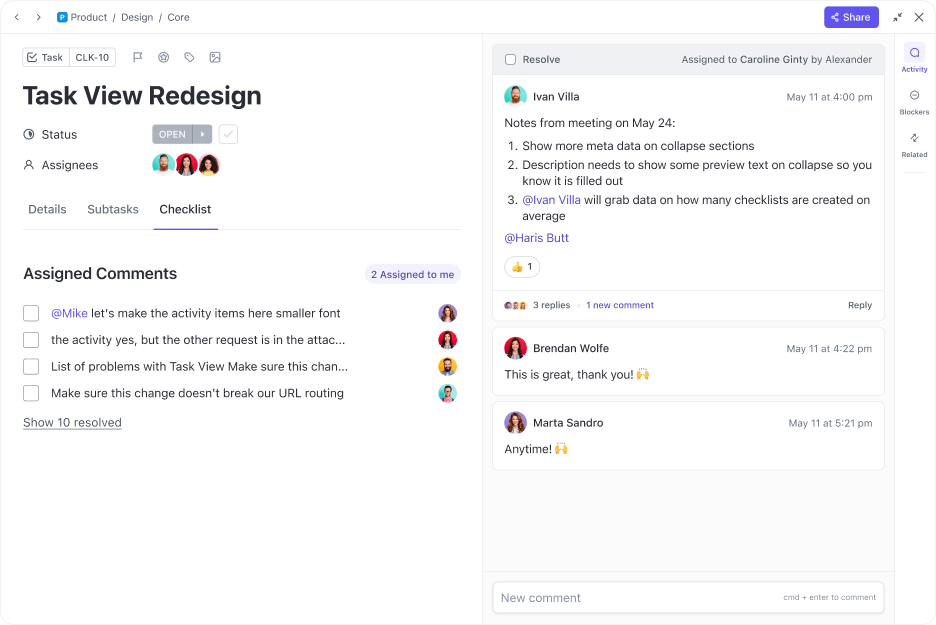
In communication models like Berlo’s SMCR, message clarity is crucial, and task comments provide a platform for ensuring that.
With threaded replies, team members can respond to specific comments, making conversations easy to follow.
I believe the communication for our larger projects, between teammates has improved. Being able to get direct conversations on a specific task or subtask has helped quality and reduced confusion.
Additionally, ClickUp Assign Comments helps teams apply accountability, making sure that everyone knows who is responsible for specific actions or tasks. This minimizes misunderstandings and guarantees that key points aren’t lost in a long chain of messages.

For example, in a product development project, a project manager can leave detailed feedback on a feature design. The designer can then reply directly within the task, addressing the feedback without jumping between emails or scattered messages.
The ability to organize these discussions right at the task level keeps communication centralized and accessible.
ClickUp Docs is a powerful tool for teams that need to collaborate in real time.

With Docs, teams can create, share, and edit documents collaboratively, making it easy to develop plans, write reports, or brainstorm ideas without ever leaving your ClickUp workspace.
Docs align with the Osgood-Schramm communication model, where continuous feedback and real-time team collaboration are critical.
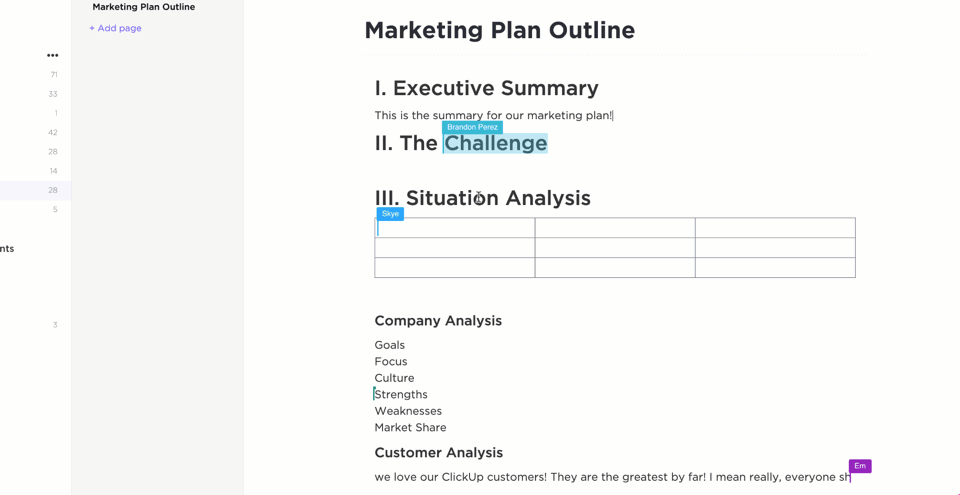
When teams can work together on a single document, it mirrors the process of encoding and decoding information, where both parties constantly send and receive feedback. This prevents communication delays and fosters a productive, collaborative environment.
For example, marketing teams can use ClickUp Docs to collaborate on a campaign plan.
Different team members can contribute ideas, leave comments, and update the document simultaneously. This improves collaboration, and everyone works with the same up-to-date information, reducing confusion.
ClickUp Whiteboards provide a visual way to collaborate, making them perfect for brainstorming sessions, mapping out processes, or even modeling communication flows.
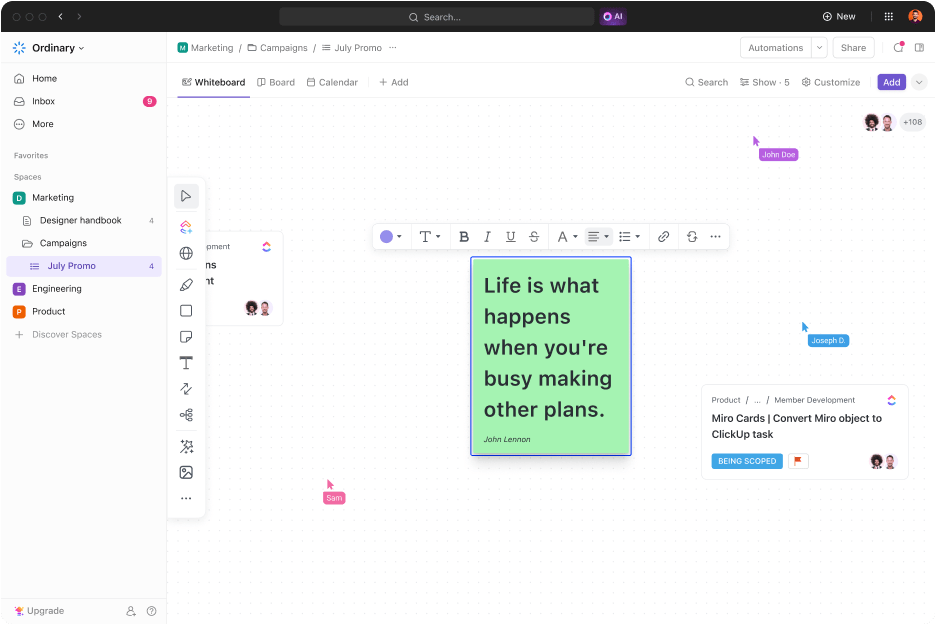
Visual communication is more effective in conveying complex ideas, and Whiteboards (like physical whiteboards) offer an interactive space for teams to work together.
This tool enhances communication by supporting concepts found in communication models like Shannon and Weaver, where the clarity of the message and reducing noise are vital.
For instance, a software development team might use Whiteboards to map out a project workflow. A visual representation of tasks, timelines, and dependencies guarantees that every team member understands the plan.

Visual aids like these also reduce miscommunication in the workplace, as everyone can see the big picture.
ClickUp has helped our team communicate on a remote team in different time zones and know what is going on in the project without having to have unnecessary meetings or ask people for information by email or Slack. The whiteboard feature helps us brainstorm processes and workflows and assign tasks in real time.
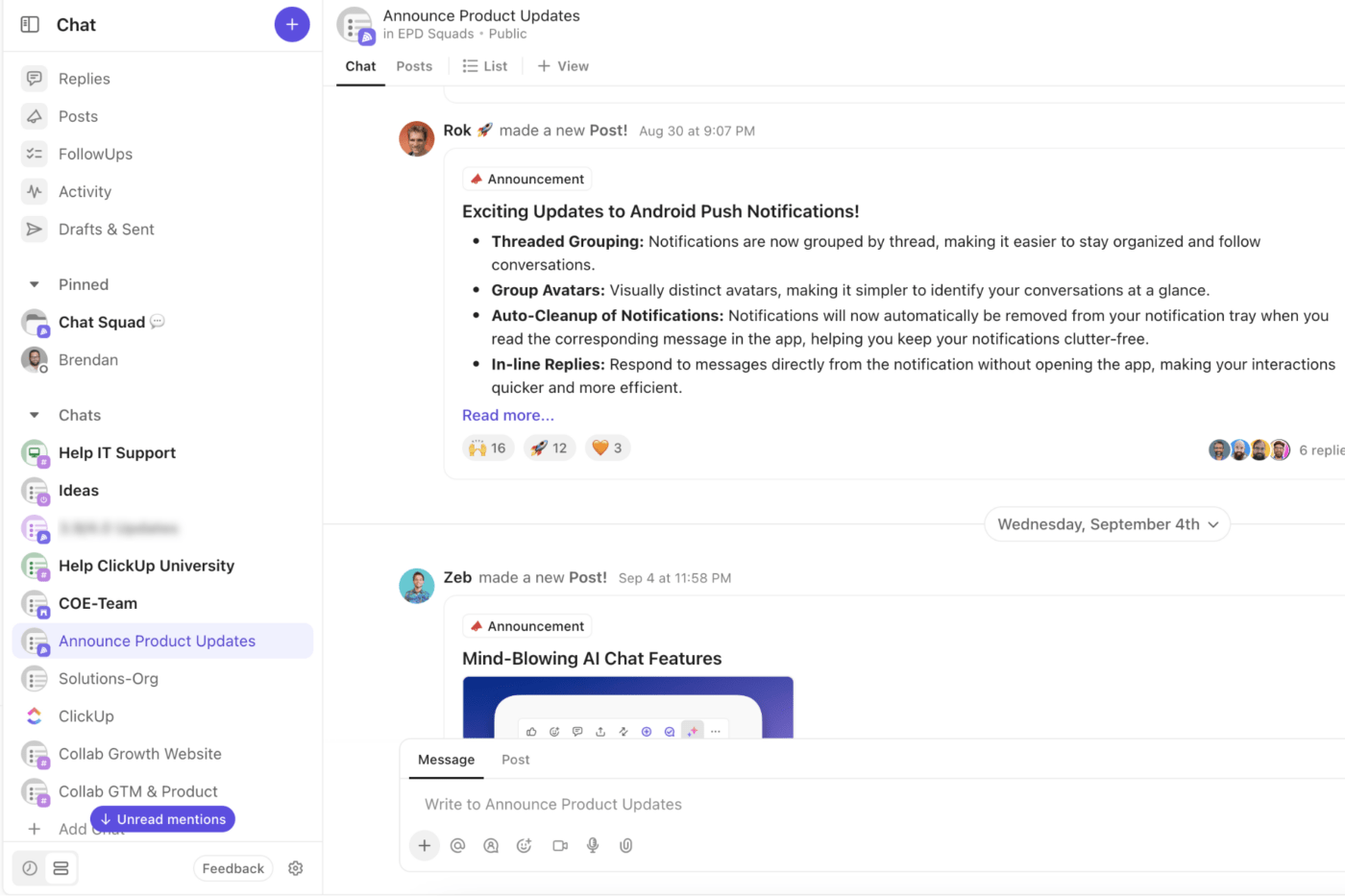
ClickUp Chat offers an in-app space for instant messaging, enabling real-time communication within teams.
Unlike long email threads, which can be difficult to follow, Chat enables immediate, clear, and concise conversations, making it an ideal tool for fast updates and quick questions.
In terms of communication models, Chat aligns with the feedback loop concept seen in models like Osgood-Schramm, where continuous interaction and immediate responses are crucial.
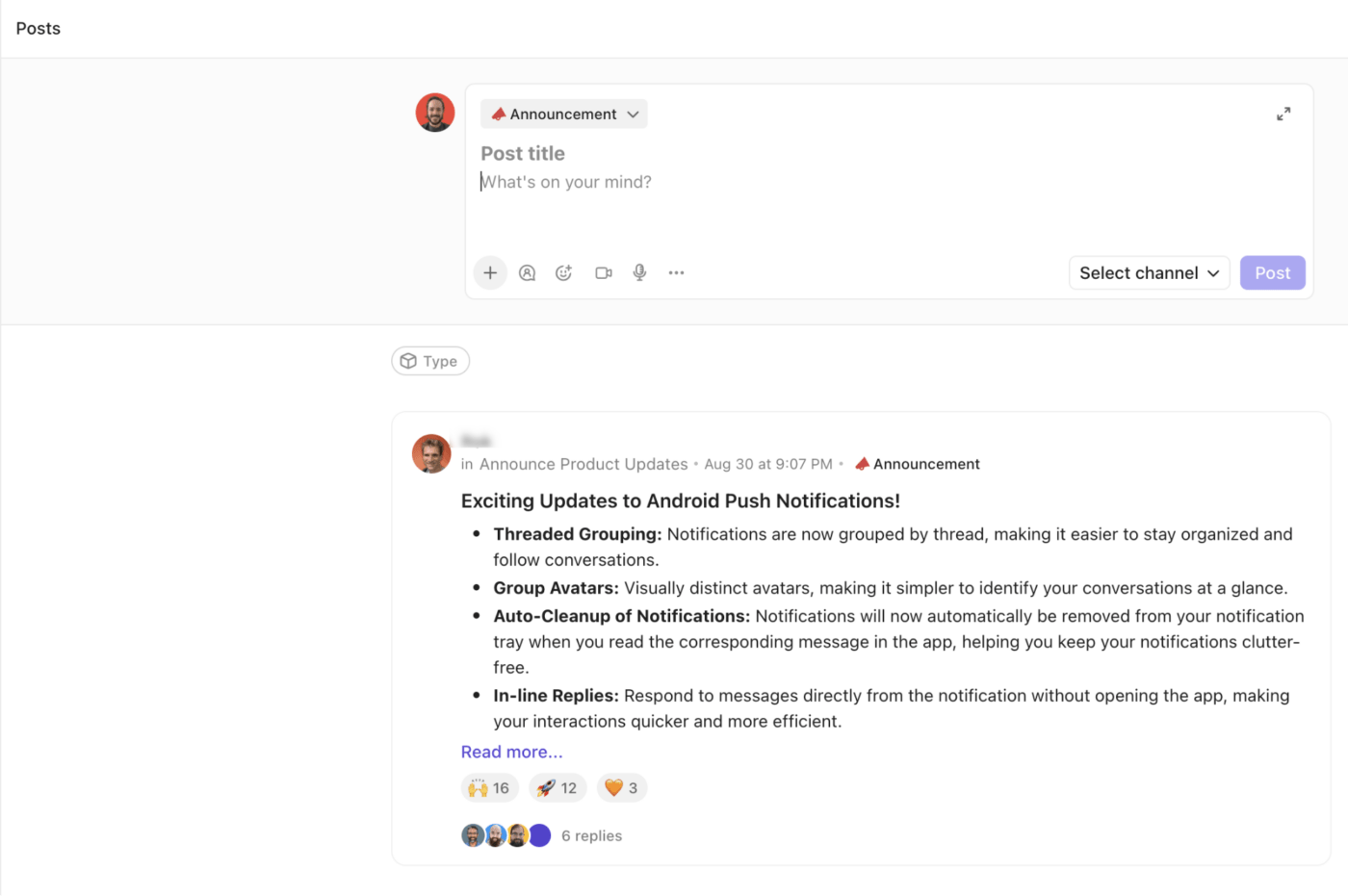
Teams that need to communicate frequently and efficiently can use Chat to stay connected and make certain that messages are understood instantly.
For example, during a busy workday, team members can use ClickUp Chat to check on project updates quickly, ask for clarification, or share relevant information without cluttering task comments or email inboxes. This speeds up decision-making and keeps the team aligned.
ClickUp Clips takes communication a step further by letting team members create and share short video messages.
These clips assist in providing detailed explanations, visual instructions, or feedback, especially when text-based communication isn’t enough.
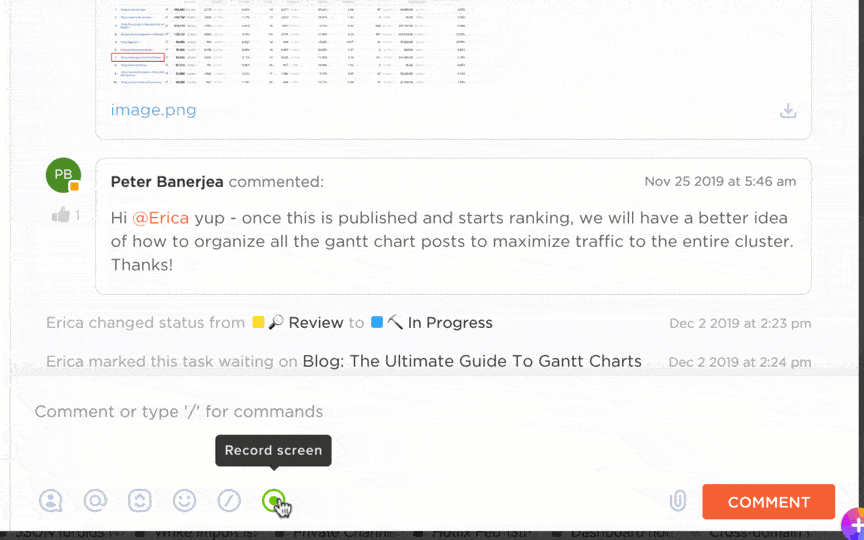
Clips are an excellent tool for aligning with communication models that accentuate clarity and effective message transmission, such as Shannon and Weaver.
Using video allows you to avoid the misinterpretations that often occur with written communication, ensuring that your message is delivered exactly as intended.
For example, a project manager might record a quick video explaining a new process to the team, walking through each step on their screen.
This method of communication is especially helpful for remote teams, as it provides a personal touch and eliminates the potential noise that could disrupt the message in written form.
💡 Pro Tip: Why not amp up team engagement with some virtual team-building activities? Think trivia quizzes or fun problem-solving games. They’re a great way to break the ice and get everyone collaborating in a lighthearted setting.
ClickUp reduces the fragmentation of messages and helps teams stay organized with 1,000+ integrations.
Centralized communication supports the concepts of the Lasswell Model, where messages need to be carefully crafted and transmitted across the right channels to reach the intended audience effectively.
With ClickUp Integrations, team members can access important communications from multiple tools without leaving the platform, simplifying collaboration and reducing potential communication gaps.

For instance, a marketing team might use Microsoft Teams for quick messages and Zoom for video calls, but all key project updates, decisions, and documents are linked directly within ClickUp.
One of the most powerful ways to improve team communication is by establishing a clear communication plan.
The ClickUp Communication Plan Template organizes and improves communication across your organization.
It provides a structured way to set clear communication goals and timelines and identify key stakeholders for consistent and effective internal and external messaging. Whether you’re aiming to enhance customer engagement or improve internal discussions, the template guides you in defining tailored objectives.
You can also define the best communication methods, whether it’s through email, social media, or another channel that aligns with your audience.
Additionally, the template includes tools to track your progress, allowing you to set milestones and measure the success of your communication efforts.
👀 Bonus: Explore additional communication plan templates to ensure clear, effective messaging across all channels.
Effective communication plays a vital role in any team, yet several barriers can impede this process.
Common obstacles include misunderstandings, information overload, and technical issues.
Misunderstandings often stem from unclear messaging, leading to confusion. Information overload occurs when overcommunication at work overwhelms recipients, making it difficult to effectively process information. Technical issues, such as poor internet connectivity or software malfunctions, disrupt communication flow and hinder team collaboration.
To tackle these challenges, teams can apply communication models like Shannon and Weaver and Berlo’s Model.
Shannon and Weaver’s model assists teams in identifying potential noise in communication, allowing for strategies that minimize interruptions. Berlo’s model emphasizes the importance of both the sender’s and receiver’s skills, which can guide teams to refine their messaging.
ClickUp can also enhance communication and overcome barriers.
For instance, ClickUp Collaboration Detection notifies team members when others are typing or viewing a task, providing real-time feedback and reducing misunderstandings. This visibility maintains clarity to keep everyone aligned.

Utilizing Task Comments helps team members clarify points and address questions directly within the task, promoting clear communication. Docs offer a centralized space for sharing important information, structured logically to facilitate understanding without overwhelming recipients.
Focusing on clarity and real-time interaction fosters a cohesive and responsive team dynamic, ultimately improving collaboration and outcomes.
💡 Pro Tip: To avoid information overload, try setting specific times during the day to check emails and messages instead of constantly monitoring them. Doing so helps you focus on tasks without distractions and keeps your mind clear for deeper work.
Communication models are essential for improving clarity, reducing misunderstandings, and enhancing team collaboration. They combat mental and emotional factors to help teams communicate effectively and boost organizational productivity.
Tools like ClickUp support these efforts by providing a centralized platform for organizing tasks, facilitating collaboration, and keeping communication clear and efficient.
Ready to improve your team’s communication?
Try ClickUp today and experience seamless collaboration and productivity firsthand!
© 2025 ClickUp